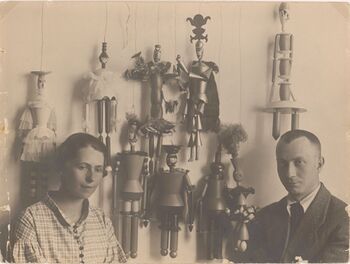Sophie Taeuber-Arp
 Nic. Aluf, Porträt mit Dada-Kopf [Portrait with Dada-Head], 1920. Gelatin silver print. 21 x 16.7 cm. | |
| Born |
January 19, 1889 Davos-Platz, Switzerland |
|---|---|
| Died |
January 13, 1943 (aged 53) Zurich, Switzerland |
| Web | Dada Companion, Wikipedia |

Sophie Henriette Gertrude Taeuber-Arp (1889-1943) was a Swiss artist, painter, sculptor, textile designer, and dancer.
Life and work[edit]
Sophie Henriette Gertrud Taeuber was born to a German father and Swiss mother and later became one of the only Swiss participants in Zurich Dada activities. Beginning in 1906, she studied decorative painting, drawing, and design at the School of Applied Arts of Saint Gall. She went to Munich in the fall of 1910, where she studied in the textile workshop of an experimental studio directed by Wilhelm von Debschitz. After a year at the School of Applied Arts in Hamburg, she returned again to Debschitz' studio until she moved to Zurich, where her sister had an apartment.
In the fall of 1915 Taeuber met Hans Arp, an Alsatian artist and poet who would later become her husband. She and Arp embarked on an experiment with abstract forms. Taeuber's previous work with abstract geometric compositions in her designs for textiles formed the foundation of their collaborative duo-collages, which were composed of cut paper arranged in strict horizontal and vertical patterns. Taeuber also produced weavings from her own and Arp's designs and was in this respect one of the first artists in Zurich Dada to demonstrate the contribution of the applied arts to the development of abstract art. Throughout her years of involvement with Dada, Taeuber was also a professor of textile design and techniques at the School of Applied Arts in Zurich.
Since 1916 Taeuber had been studying dance with Rudolf Laban, a Swiss modern dancer and choreographer who advocated a radical form of expressive movement. In April of that year, Taeuber and Mary Wigman, a student of Laban's who would go on to become a prominent modern dancer, began performing at the Cabaret Voltaire dressed in costumes designed by other members of the Dada circle. Because the Zurich School of Applied Arts disapproved of their professors taking part in Dada activities, she danced under a pseudonym.
In 1918 Taeuber received a commission to design the stage sets and marionettes for a production of Carlo Gozzi's play Il re cervo [König Hirsch; King Stag], adapted by Werner Wolff and René Morax. It was the first performance of its kind to integrate Dada and psychoanalysis. The animating conflict of the play was the 1913 controversy between Sigmund Freud and Carl Jung over the character of the libido. Taeuber commented ironically on this antagonism by creating marionettes whose inherent freedom from the constraints of human anatomy and motion allowed them to manifest interior, or psychic, states in their physical forms. Between 1920 and 1926 Taeuber traveled extensively, taking vacations with Hans Arp that were often spent in the company of other dadaists like Max Ernst, Paul Eluard, and Tristan Tzara, or Kurt Schwitters and Hannah Höch. After settling in Strasbourg, Taeuber received a commission to decorate an entertainment complex in the center of town called the Aubette. She, Arp, and Theo van Doesburg shared the project. Arp and Taeuber moved to Paris in 1928, where they lived until 1940, when World War II forced them to flee to southern France. Tragically, Taeuber died of accidental gas poisoning in 1943 while she and Arp were in Zurich attempting to obtain passage to the United States. (Source)
Catalogues[edit]
- Carolyn Lanchner, Sophie Taeuber-Arp, New York: Museum of Modern Art, 1981, 53 pp. [2]
Literature[edit]
- Renée Riese Hubert, "Zurich Dada and Its Artist Couples", in Women in Dada: Essays on Sex, Gender, and Identity, ed. Naomi Sawelson-Gorse, MIT Press, 1998, pp 516-545. (English)
- Ruth Hemus, "Sophie Taeuber", in Hemus, Dada's Women, Yale University Press, 2009, pp 53-90. (English)
- Nell Andrew, "Dada Dance: Sophie Taeuber's Visceral Abstraction", in Andrew, Moving Modernism: The Urge to Abstraction in Painting, Dance, Cinema, Oxford University Press, 2020, pp 79-102. (English)
See also[edit]
Links[edit]
- Arp Museum, Bahnhof Rolandseck, Remagen
- Biography by Arp Foundation
- Biography and works in 2006 Dada exhibition at NGA
- Retrospective at Aargauer Kunsthaus, 2014
